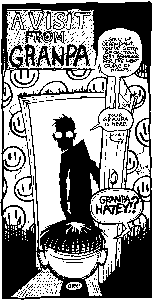Beta Males
A new generation of comic-book artists salutes slackerdom
CONSIDER THE FOLLOWING small survey of American beta males. The characters in five recent small-press comics represent a composite picture of loser manhood, from young male to divorced 40-year-old.
Jhonen Vasquez's misfit hero, Squee (Squee! #2; $2.95; Slave Labor Graphics), who looks like a Keane big-eyed kid painting done by Edvard Munch, fades into Pete Sickman-Garner's Young Tim (Hey, Mister; $4.95; P.O. Box 4085, Fayetteville, AR 72702-4085), who bears a coincidental resemblance to Squee's favorite one-toothed stuffed animal.
Eno, Terry LaBan's shiftless protagonist (Eno and Plum; $2.95; Oni Press), and Rob, Bob Fingerman's semiautobiographical character (Minimum Wage #8; $2.95; Fantagraphics), represent a brief flourishing of slackers ensconced in a part of the city they can afford: an urban slum. But in Gene Mahoney's story "Whatever Happened to Overgrown Adolescent Jon?" (The Silicon Valley Review #6; 25 cents, P.O. Box 843, Redwood City, CA 94064), we get the last chapter: an outlandish horror story about what becomes of a wretched musician friend whose "record finally came out. Unfortunately, so did millions of others."
Skateboard companies now pilfer local-guy Vasquez's art from his infamous Johnny the Homicidal Maniac, but Squee! is better work. Squee! is less about killer attitude and more about the realistic--if visually exaggerated--pressures brought to bear on a little kid. Vasquez's subject is bad dreams, strange bathrooms and stranger relatives, including an especially cruel superhero parody of the idealized comic-book male: 500 pounds of muscle on a pair of birdy legs.
Sickman-Garner overcomes his minor limitations as an artist by shrinking the images in Hey, Mister--and you get a lot of very good material for not very much money. (If the audience for beta-male funnies is indeed working for minimum wage, a comic book ought to last at least as long as the time spent working for it.)
The characters include my favorite--a sour-faced young female barfly called Aunt Mary--but the story mainly concentrates on the adventures of sad-eyed Young Tim. Kicked out by his parents, Tim attempts to organize a Club Love for the lonely. Naturally, only one member shows up, asking, "So, where are the hookers?"
Eno and Plum and Minimum Wage #8 mine the same material: angst-ridden 20-somethings trying to claw out a life for themselves. More of a yarn, Eno and Plum leaves the hip ghetto and takes off for the woods. The two main characters--done in Chicagoan LaBan's usual hilarious style--are a harmonious cross between Elzie Segar's Popeye and Archie comics. Minimum Wage, a less fanciful tale of slacker life, benefits from Fingerman's appealing artwork. He tracks the travails of a goateed hero trying to make his way through Brooklyn pestered by macho friends and fag-baiters alike.
MAHONEY'S SELF-PUBLISHED Silicon Valley Review features the highly recommended--and fictional (I hope)--tale of an awful musician named Jon, who descends from discerning rock snob to born-again Christian to devotee of a Hare Krishna-like cult.
The highlight comes when Jon gets a full ration of Florida hospitality: beaten up in a bar; picked up by the police for drunken driving on the way home and--"You know how those hick-town cops are"--beaten up again; then tossed into the drunk tank and beaten up by the inmates. Finally, after making his way home at dawn, he's beaten up by his wife's lover as punishment for waking them up.
What would Vince Lombardi say? When I was a kid, I found out that Robert Williams, the underground cartoonist, was living on the same North Hollywood street as my best friend. How I longed for the guts to call on him. Later, I read an interview with this peerless limner of zombie clowns, diseased poodles and devil girls, and I learned that he was a hot-rodder, the kind of guy who carries a pack of Luckies rolled up in the T-shirt sleeve of one brawny arm. Williams said that he'd always imagined his readers as being handsome physical specimens--"centaurs" is the word I think he used--and then he went to a comic-book convention and got a load of his beta-male fan base.
Of course, if I'd actually rung his doorbell, he would have gotten a clue a lot earlier. The new generation of loser artists knows its fans all too well. Their comics give us the stations of the way-too-sensitive guy's cross, from bug-eyed childhood to shaven-headed adult loon.
[ San Jose | Metroactive Central | Archives ]
Copyright © Metro Publishing Inc. Maintained by Boulevards New Media.
![]()
 Relative Terror: Jhonen Vasquez's misfit hero, Squee, confronts multiple obstacles in his race to grow up and get out--including a babysitting grandpa.
Relative Terror: Jhonen Vasquez's misfit hero, Squee, confronts multiple obstacles in his race to grow up and get out--including a babysitting grandpa.
From the June 4-10, 1998 issue of Metro.
![[Metroactive Books]](/books/gifs/books468.gif)